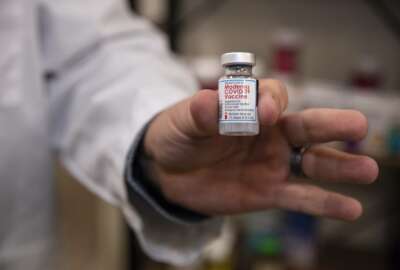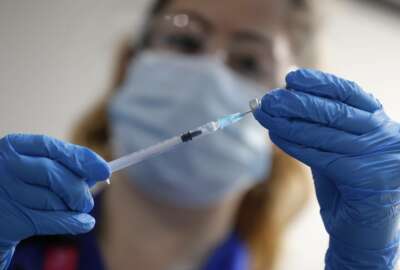
Supply remains VA’s biggest hurdle in vaccinating broader veteran population
The Department of Veterans Affairs says it's been able to vaccinate its health care workers with relative speed, but reaching the broader veteran population has and...
The Department of Veterans Affairs has managed to fully vaccinate a significant portion of its health care workforce, but reaching the broader population of veterans has and will continue to be a challenge.
The Department of Health and Human Services has so far allotted roughly 6 million doses to VA for veterans and 400,000 doses for the agency’s employees, as well as additional doses to vaccinate roughly 23,000 employees at the Department of Homeland Security.
VA receives those supplies in weekly shipments of roughly 140,000 doses, Richard Stone, VA’s acting undersecretary for health, told members of a House Appropriations subcommittee Friday.
The department began vaccinating some DHS employees in early January. The two departments signed an inter-agency agreement, which allows eligible DHS employees to visit a nearby VA hospital to receive their COVID-19 vaccine.
To date, VA has administered more than 1.3 million doses of the COVID-19 vaccine, according to the department’s public data source.
Of that total, 259,905 employees at the Veterans Health Administration have received at least one dose, with 220,034 employees having received both doses.
Some VA hospitals have vaccinated up to 90% of their workforces, which Stone said has freed up more personnel to care for and inoculate more veterans.
On any given day prior to vaccination, VHA had 5,000-to-6,000 employees who couldn’t come to work during the pandemic, either because they had been exposed to, or had COVID-19 themselves, he said.
Today, there are 1,300 people across the VHA health care system who can’t come to work due to potential exposure or illness.
“Our health care workers, both clinical and non-clinical, are coming to work at higher rates than they ever have,” Stone said. “The amount of vacation taken is at unprecedented and historic low rates, especially in areas that are getting hit hardest by the pandemic.”
Fewer VHA employees have retired during the last year, as well, he added. Still, the last year has been difficult for the workforce.
“The effect on the employees hasn’t been just the disease,” Stone said. “It’s been the changes in what’s happening to their families. It’s been about moms who are struggling in caring for their children who aren’t in organized school all day. Everybody’s lives have been turned upside down. It’s the inability to take care of elderly family members because you just can’t get in to see them at an institution.”
VA seeks more funding for pandemic response
While VA has been relatively quick to inoculate its health care workers who were first priority under the department’s vaccination plan, reaching the broader veteran population has and will continue to be more difficult with limited supply.
More than 1 million veterans have received at least one dose of the COVID-19 vaccine, according to VA’s public data.
When it comes to vaccinating veterans, VA is focused on the 9.3 million who are enrolled with the department to receive health services.
“For those who are enrolled that have depended on us as a safety net for them, they are our first priority,” Stone said. “We do recognize however that there are substantial areas of the country where veterans are not coming in to get their vaccinations. In one area of New York alone in a single catchment area, over 1,000 veterans over age 75 said ‘no thank you.’ That surprised us. We do have some supply. Therefore, we are enrolling veterans on the spot.”
Still, VA doesn’t haven’t the supplies to vaccinate the broader population of veterans who aren’t eligible for VA health care at this time, Stone said.
Debbie Wasserman Schultz (D-Fla.), chairman of the House Appropriations Subcommittee on Military Construction and Veterans Affairs, urged VA to find a way to reach this group.
“There are ways that VA can meet the needs of this population, without Congress stepping in and making any statutory change,” she said. “We want you to think creatively and explore all the options to reach this population.”
Stone said VA is actively discussing options with HHS and the Centers for Disease Control and Prevention.
The department could, as both Stone and Wasserman Schultz mentioned, work with FEMA to designate the task of vaccinating veterans who aren’t eligible for VA health care as a “fourth mission.”
In the meantime, VA is on the hunt for additional funding for its COVID-19 response. The Biden administration has proposed another $17 billion for the department, which House Democrats are hoping to secure through the budget reconciliation process.
Republicans in Congress, however, have been deeply skeptical of the funding request. Congress already gave VA more than $19 billion last year through the Coronavirus Aid, Relief and Economic Security (CARES) Act.
The department obligated $6.5 billion of that funding for COVID-19 response during the last year. It’ll commit the remaining funds during this fiscal year, Stone said. Additional funding would go toward healthcare costs and personal protective equipment, VA said, as well as several large-scale modernization efforts.
“We have begun discussing exactly what the long-term effect of this pandemic means to us,” Stone said. “We know that there’s a huge impact on deferred and delayed care that will begin to come in. We know that there’s a huge effect on unemployment, where people lose their health insurance and come to us as a safety net. We know there’s a huge effect on the modernization of our systems that have been so challenged. We operate a pretty old telephone system in many of the areas of the country. We need to modernize those phone systems.”
In addition, VA is also eyeing the extra funding as a way to better plan for future disasters — and make needed upgrades to its facilities.
“We also need to recognize that there may be another pandemic,” Stone added. “There may be a variant. There may be an earthquake. We need to begin to prepare ourselves to assure that we can not only complete our mission here but also pick up whatever this nation may need.”
Copyright © 2025 Federal News Network. All rights reserved. This website is not intended for users located within the European Economic Area.
Nicole Ogrysko is a reporter for Federal News Network focusing on the federal workforce and federal pay and benefits.
Follow @nogryskoWFED
Related Stories
VA health care workers feeling pandemic burnout: ‘We don’t see the light at the end of the tunnel’





